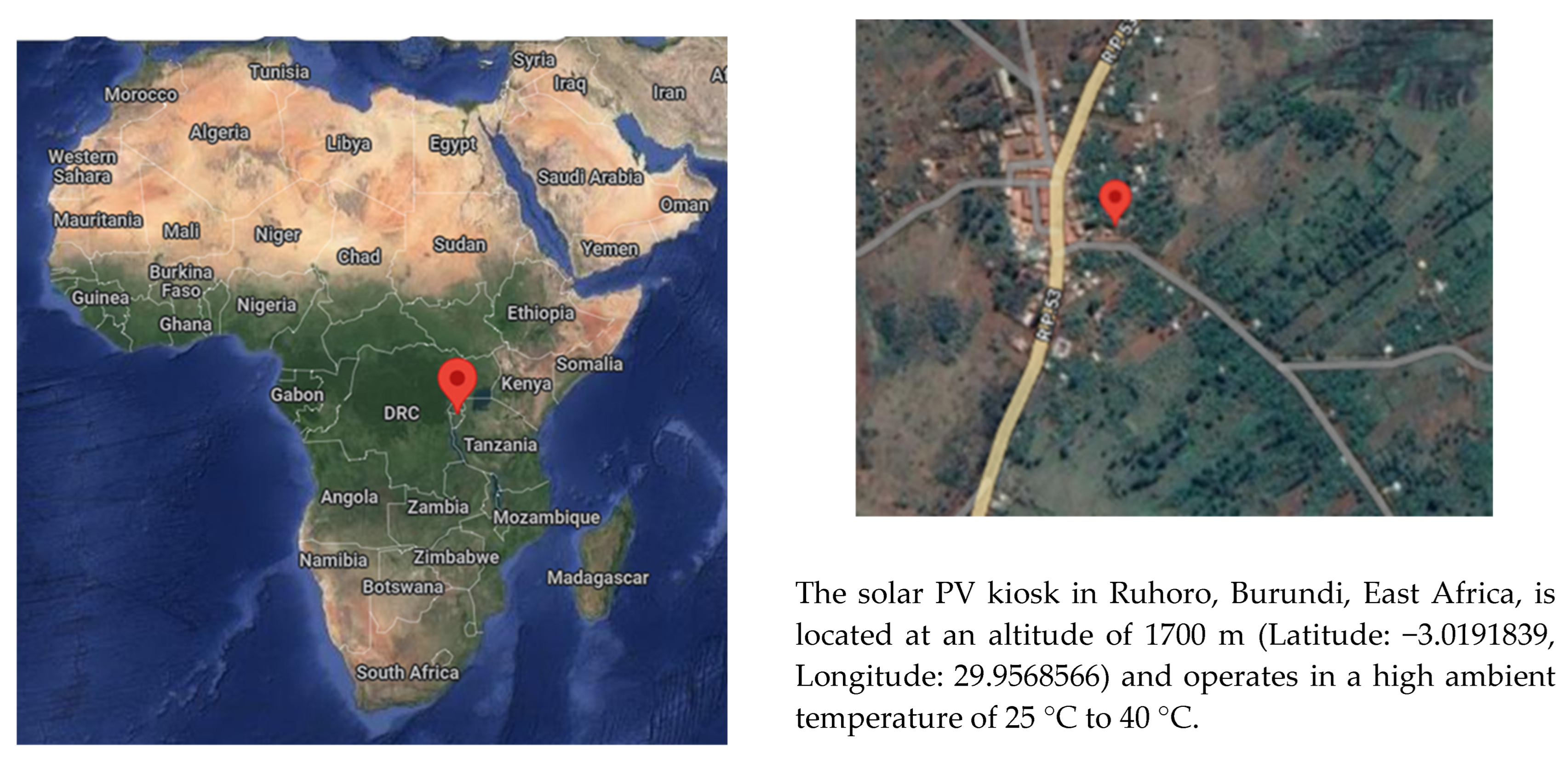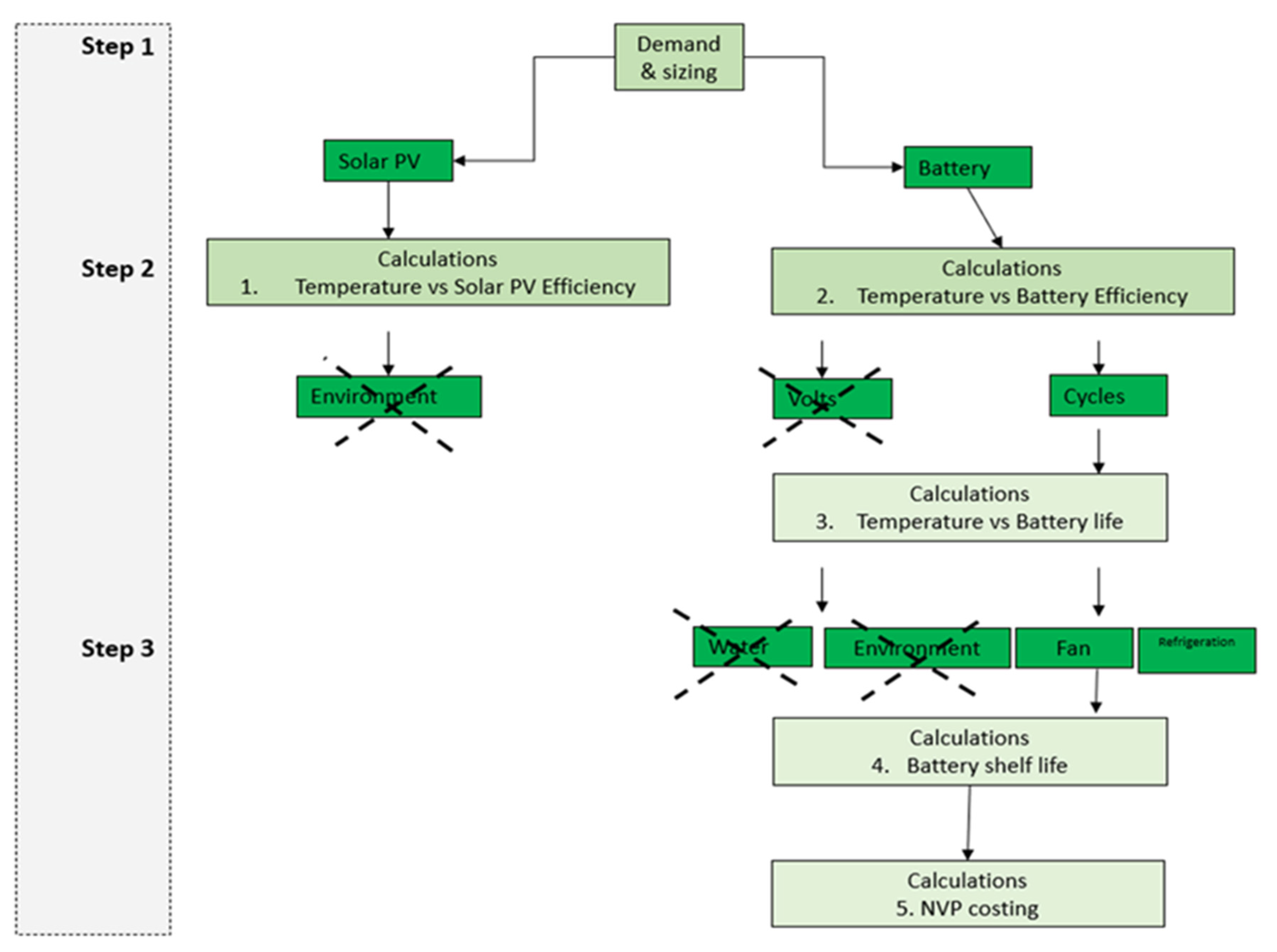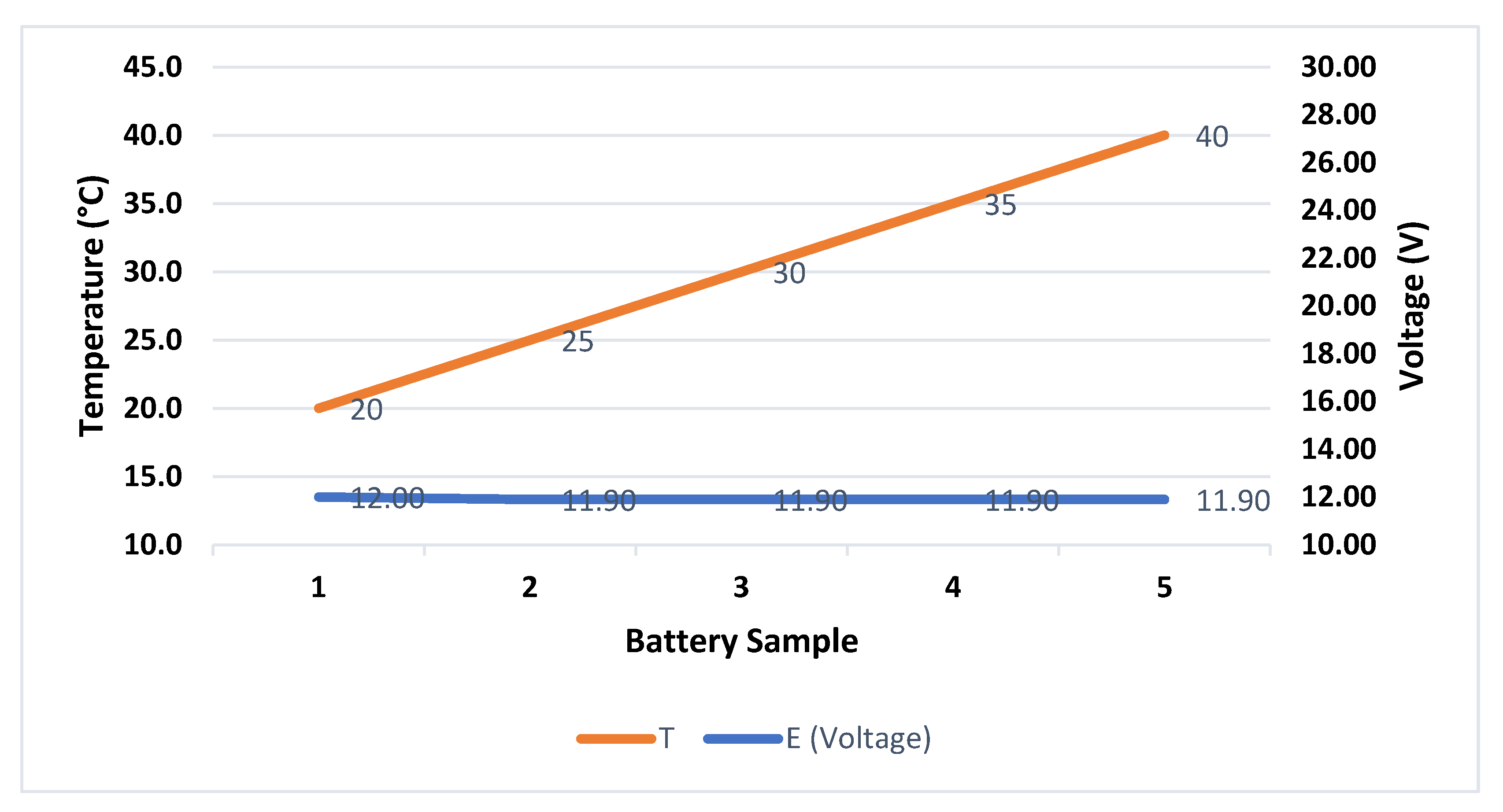Redesigning a Solar PV Kiosk in High-Temperature Environments of Burundi, Africa
Abstract
:1. Introduction
2. Materials and Methods
2.1. Impact of High Temperature on Solar PV
2.2. Impact of High Temperature on Ultracel Gel Battery (12 v 250 A C10 Gel)
2.2.1. Efficiency Changes in the Battery
2.2.2. Temperature Impact on Battery Life
2.3. Step 3—Battery Cooling Technology Options
- Battery without any cooling method
- Battery with DC fan cooling
- Battery with refrigeration cooling
3. Results
3.1. Demand and Sizing
3.2. Solar PV vs. Temperature. Calculation
3.3. Batteries vs. Temperature
- A factor of safety of 0.7 allows for gaining an optimum temperature. It will vary with increased temperature. The formula is applied, reducing the factor of safety as temperature increases.
- The battery capacity of 250 Ah (see appendix) is 250,000 mAh.
- The load current is 12,000 mA
3.4. Battery Cooling Options
3.5. Cooling System Costings
- Rent of electric sockets for phone charging and barbers at 200 USD per month = USD 2400 per annum
- Rent of 250 lamps at 1 USD per lamp per month = USD 3000 per annum
- Computer printer of 16,000 pages per month at 15 USD per month = 180
- 1 canal+ rent at 15 USD per month = USD180
4. Discussion
5. Conclusions
Funding
Acknowledgments
Conflicts of Interest
References
- World Bank. Access to Electricity Report 2022. Available online: https://data.worldbank.org/indicator/EG.ELC.ACCS.ZS?locations=BI (accessed on 1 February 2021).
- Hoppmann, J.; Volland, J.; Schmidt, T.S.; Hoffmann, V.H. The Economic Viability of Battery Storage for Residential Solar Photovoltaic Systems—A Review and a Simulation Model. Renew. Sustain. Energy Rev. 2014, 39, 1101–1118. [Google Scholar] [CrossRef]
- Hill, C.A.; Such, M.C.; Chen, D.; Gonzalez, J.; Grady, W.M. Battery Energy Storage for Enabling Integration of Distributed Solar Power Generation. IEEE Trans Smart Grid 2012, 3, 850–857. [Google Scholar] [CrossRef]
- Madziga, M.; Rahil, A.; Mansoor, R. Comparison between Three Off-Grid Hybrid Systems (Solar Photovoltaic, Diesel Generator and Battery Storage System) for Electrification for Gwakwani Village, South Africa. Environments 2018, 5, 57. [Google Scholar] [CrossRef] [Green Version]
- UNICEF ESARO. Regional Report on Renewable Energy for Health and Education in the East and Southern Africa Region; UNICEF ESARO: Nairobi, Kenya, 2022. [Google Scholar]
- USAID. Cost-Benefit Analysis of Off-Grid Solar Investments in East Africa; USAID, 2017, Unpublished. Available online: https://www.usaid.gov/sites/default/files/documents/1865/Cost-Benefit-Analysis-Off-Grid-Solar-Investments-East-Africa.pdf (accessed on 3 September 2022).
- Alshawaf, M.; Poudineh, R.; Alhajeri, N.S. Solar PV in Kuwait: The Effect of Ambient Temperature and Sandstorms on Output Variability and Uncertainty. Renew. Sustain. Energy Rev. 2020, 134, 110346. [Google Scholar] [CrossRef]
- Aldihani, A.; Aldossary, A.; Mahmoud, S.; Al-Dadaha, R.K. The Effect of Cooling on the Performance of Photovoltaic Cells under Dusty Environmental Conditions. In Proceedings of the 6th International Conference on Applied Energy, Taipei, Taiwan, 30 May–2 June 2014. [Google Scholar]
- Charfi, W.; Chaabane, M.; Mhiri, H.; Bournot, P. Performance Evaluation of a Solar Photovoltaic System. Energy Rep. 2018, 4, 400–406. [Google Scholar] [CrossRef]
- Siecker, J.; Kusakana, K.; Numbi, B.P. A Review of Solar Photovoltaic Systems Cooling Technologies. Renew. Sustain. Energy Rev. 2017, 79, 192–203. [Google Scholar] [CrossRef]
- Abdullah, A.A.; Attulla, F.S.; Ahmed, O.K.; Algburi, S. Effect of Cooling Method on the Performance of PV/Trombe Wall: Experimental Assessment. Therm. Sci. Eng. Prog. 2022, 30, 101273. [Google Scholar] [CrossRef]
- Muzathik, A.M. Photovoltaic Modules Operating Temperature Using a Simple Correlation. Int. J. Energy Eng. 2014, 4, 151–158. [Google Scholar]
- Jossen, A.; Garche, J.; Sauer, D.U. Operation Conditions of Batteries in PV Applications. Sol. Energy 2004, 76, 759–769. [Google Scholar] [CrossRef]
- Ma, S.; Jiang, M.; Tao, P.; Song, C.; Wu, J.; Wang, J.; Deng, T.; Shang, W. Temperature Effect and Thermal Impact in Lithium-Ion Batteries: A Review. Prog. Nat. Sci. Mater. Int. 2018, 28, 653–666. [Google Scholar] [CrossRef]
- Ouyang, D.; Weng, J.; Chen, M.; Wang, J. Impact of High-Temperature Environment on the Optimal Cycle Rate of Lithium-Ion Battery. J. Energy Storage 2020, 28, 101242. [Google Scholar] [CrossRef]
- Chen, M.; Xie, S.; Zhao, X.; Zhou, W.; Li, Y.; Zhang, J.; Chen, Z.; Chao, D. Aqueous Zinc-Ion Batteries at Extreme Temperature: Mechanisms, Challenges, and Strategies. Energy Storage Mater. 2022, 51, 683–718. [Google Scholar] [CrossRef]
- Ponnusamy, M.; Manimekalai, P.; Harikumar, R.; Raghavan, S. An Overview of Batteries for Photovoltaic (PV) Systems. Int. J. Comput. Appl. 2013, 82, 975–8887. [Google Scholar]
- Koko, S.P. Optimal Battery Sizing for a Grid-Tied Solar Photovoltaic System Supplying a Residential Load: A Case Study under South African Solar Irradiance. Energy Rep. 2022, 8, 410–418. [Google Scholar] [CrossRef]
- Das, M.; Mandal, R. Effect of Solar Radiation and Operating Factor of the PV Module on the Loss of Load Probability of a PV-Battery System. Mater. Today Proc. 2022, 56, 2767–2773. [Google Scholar] [CrossRef]
- Gul, E.; Baldinelli, G.; Bartocci, P.; Bianchi, F.; Domenighini, P.; Cotana, F.; Wang, J. A Techno-Economic Analysis of a Solar PV and DC Battery Storage System for a Community Energy Sharing. Energy 2022, 244, 123191. [Google Scholar] [CrossRef]
- Salameh, T.; Zhang, D.; Juaidi, A.; Alami, A.H.; Al-Hinti, I.; Olabi, A.G. Review of Solar Photovoltaic Cooling Systems Technologies with Environmental and Economical Assessment. J. Clean. Prod. 2021, 326, 129421. [Google Scholar] [CrossRef]
- Muruganantham, B.; Gnanadass, R.; Padhy, N.P. Challenges with Renewable Energy Sources and Storage in Practical Distribution Systems. Renew. Sustain. Energy Rev. 2017, 73, 125–134. [Google Scholar] [CrossRef]
- Luerssen, C.; Gandhi, O.; Reindl, T.; Sekhar, C.; Cheong, D. Life Cycle Cost Analysis (LCCA) of PV-Powered Cooling Systems with Thermal Energy and Battery Storage for off-Grid Applications. Appl. Energy 2020, 273, 115145. [Google Scholar] [CrossRef]
- Jankowiak, C.; Zacharopoulos, A.; Brandoni, C.; Keatley, P.; MacArtain, P.; Hewitt, N. Assessing the Benefits of Decentralised Residential Batteries for Load Peak Shaving. J. Energy Storage 2020, 32, 101779. [Google Scholar] [CrossRef]
- Lai, C.S.; McCulloch, M.D. Levelized Cost of Electricity for Solar Photovoltaic and Electrical Energy Storage. Appl. Energy 2017, 190, 191–203. [Google Scholar] [CrossRef]
- Salim, H.K.; Stewart, R.A.; Sahin, O.; Dudley, M. Drivers, Barriers and Enablers to End-of-Life Management of Solar Photovoltaic and Battery Energy Storage Systems: A Systematic Literature Review. J. Clean Prod. 2019, 211, 537–554. [Google Scholar] [CrossRef]
- Markvart, T. (Ed.) Solar Electricity; John Wiley & Sons: Hoboken, NJ, USA, 2000; Volume 6. [Google Scholar]
- Nian, Q.; Sun, T.; Liu, S.; Du, H.; Ren, X.; Tao, Z. Issues and Opportunities on Low-Temperature Aqueous Batteries. Chem. Eng. J. 2021, 423, 130253. [Google Scholar] [CrossRef]
- The Open University. T313 Renewable Energy Unpublished; Open University Press: London, UK, 2020. [Google Scholar]
- Solar, J.A. JA Solar Manufacturer’s Literature 2022. Available online: https://www.jasolar.com/uploadfile/2018/0807/20180807045422860.pdf (accessed on 1 February 2021).
- Pedersen, D.; Lybbert, M.; Warren, R. Life Cycle Analysis of LiCoO2/ Graphite Batteries with Cooling Using Combined Electrochemical-Thermal Modeling. Resour. Conserv. Recycl. 2022, 180, 106204. [Google Scholar] [CrossRef]
- Yang, D.; He, Y.; Wu, B.; Deng, Y.; Li, M.; Yang, Q.; Huang, L.; Cao, Y.; Liu, Y. Drinking Water and Sanitation Conditions Are Associated with the Risk of Malaria among Children under Five Years Old in Sub-Saharan Africa: A Logistic Regression Model Analysis of National Survey Data. J. Adv. Res. 2019, 21, 1–13. [Google Scholar] [CrossRef]






| 2022 | 2025 | ||
|---|---|---|---|
| Demand | Uses includes internet café and community center | 15.06 kWh/day | 16.5 kWh/day |
| Supply | Solar PV (6 panels × 2.25 kWp × 10 h) 2775 kWh per year per panel | 45.6 kWh/day | 45.6 kWh/day |
| 90% efficiency of the solar panels due to losses through the hybrid inverter (90%) |
| Temperature (°C) | Energy (kWh/m2) | * PV Array Surface Area m2 | Panel Efficiency (% Per Panel) | Solar Irradiance (kwh/day/m2) |
|---|---|---|---|---|
| 20 | 3.8 | 1.9 | 30 | 64.7 |
| 25 | 3.6 | 1.9 | 29 | 64.7 |
| 30 | 3.5 | 1.9 | 28 | 64.7 |
| 35 | 3.4 | 1.9 | 27 | 64.7 |
| 40 | 3.3 | 1.9 | 26 | 64.7 |
| Temperature (°C) | Panel Efficiency | Efficiency Change |
|---|---|---|
| 20 | 30 | 2.5 |
| 25 | 25 | 1.5 |
| 30 | 20 | 1 |
| 35 | 18 | 0.0 |
| 40 | 16 | 0.2 |
| Temperature (°C) | Safety Factor | Battery Life (Years) |
|---|---|---|
| 20 | 0.7 | 14.6 |
| 25 | 0.6 | 12.5 |
| 30 | 0.5 | 10.4 |
| 35 | 0.4 | 8.3 |
| 40 | 0.3 | 6.2 |
| Cooling Option | Cfan J/m3 | Ibattery (W/m2) | Apv (m2) | Vair (Watts) | Additional Annual Energy Requirement (kWh/day) |
|---|---|---|---|---|---|
| No cooling | 0.0006 | 64.7 | 1.4 | 0.05 | 0.0006 |
| Fan cooling | 1,008,000 | 64.7 | 1.4 | 91,304,640 | 0.28 |
| Refrigeration cooling | 19,008,000 | 64.7 | 1.4 | 1,721,744,640 | 5.28 |
60,000 J/m3 = 1 kWh/m3. Thus, applying the formula from Abdullah et al. [8]:
| |||||
| No Cooling | Fan Cooling | Refrigeration Cooling | |
|---|---|---|---|
| Demand Annual energy requirement in 2025 (kWh/day) | 16.5006 kWh/day (16.5 + 0.0006) | 16.78 kWh/day (16.5 + 0.28) | 21.78 kWh/day (16.5 + 5.28) |
| Supply | 20.25 kWh/day | 20.25 kWh/day | 23.63 kWh/day |
| Solar PV |
| Component | CAPEX Costs (USD) | ||
|---|---|---|---|
| No Cooling | Fan Cooling | Refrigeration Cooling | |
| PV CAPEX | 12,000 | 12,000 | 14,000 |
| Inverter (5 kvA for 23 kWh system) | 9000 | 9000 | 9000 |
| Batteries 1 | 15,000 | 15,000 | 18,750 |
| Replacement batteries (after 6 years) | 30,000 | 15,000 | 0 |
| Wiring kit | 7000 | 7000 | 8000 |
| Labor | 2600 | 2600 | 2600 |
| Construction | 17,000 | 17,000 | 17,000 |
| Fan | 500 | ||
| Fridge | 1500 | ||
| USD 94,625 | USD 80,125 | USD 72,875 | |
| No Cooling | Fan Cooling | Refrigeration Cooling | |
|---|---|---|---|
| CAPEX C0 (USD) | 94,625 | 80,125 | 72,875 |
| N (Number of Years) | 6.2 | 10 | 15 |
| I (Discount Rate) | 0.111 | 0.111 | 0.111 |
| R (Yearly Revenue in USD) | 5760 | 5760 | 5760 |
| NPV (USD) | USD −62,481 | USD −28,279 | USD 4893 |
Disclaimer/Publisher’s Note: The statements, opinions and data contained in all publications are solely those of the individual author(s) and contributor(s) and not of MDPI and/or the editor(s). MDPI and/or the editor(s) disclaim responsibility for any injury to people or property resulting from any ideas, methods, instructions or products referred to in the content. |
© 2023 by the author. Licensee MDPI, Basel, Switzerland. This article is an open access article distributed under the terms and conditions of the Creative Commons Attribution (CC BY) license (https://creativecommons.org/licenses/by/4.0/).
Share and Cite
Godfrey, S. Redesigning a Solar PV Kiosk in High-Temperature Environments of Burundi, Africa. Sustainability 2023, 15, 5514. https://doi.org/10.3390/su15065514
Godfrey S. Redesigning a Solar PV Kiosk in High-Temperature Environments of Burundi, Africa. Sustainability. 2023; 15(6):5514. https://doi.org/10.3390/su15065514
Chicago/Turabian StyleGodfrey, Samuel. 2023. "Redesigning a Solar PV Kiosk in High-Temperature Environments of Burundi, Africa" Sustainability 15, no. 6: 5514. https://doi.org/10.3390/su15065514





